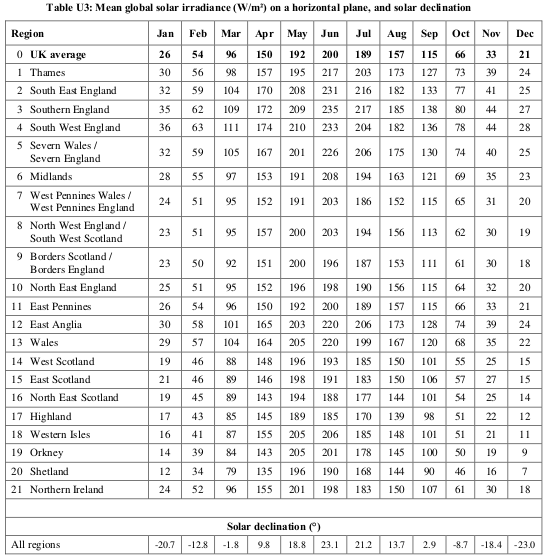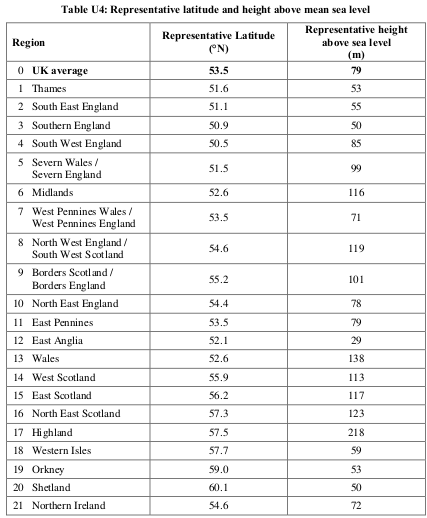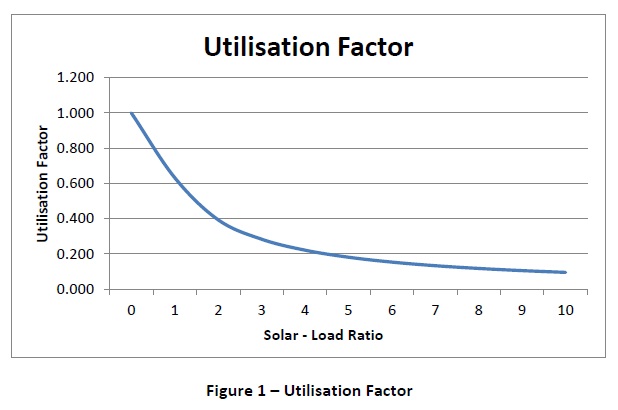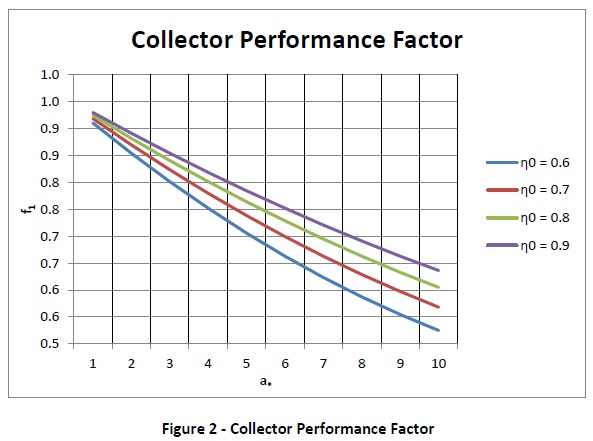estimate solar thermal contributions
| solar_calculator.xlsx | |
| File Size: | 176 kb |
| File Type: | xlsx |
To estimate the contributions a solar thermal collector is able to make to heating requirements, a tool was created which could be used either in conjunction with the Carbon Trust Biomass Decision Support Tool or as a standalone tool. It was important that, like the Biomass Decision Support Tool, it had broad applicability. This proved difficult however, as the contribution that a solar thermal collector is able to make to heating requirements is dependent on a large number of factors.
The power output from a solar thermal collector can be modelled in the steady state condition using the equation:
The power output from a solar thermal collector can be modelled in the steady state condition using the equation:
Where,
This equation has been widely used in both testing and simulation of solar thermal collectors [1]. Because it is a steady state equation however, to accurately determine the power output from the collector over a period of time a dynamic simulation would have to be run with sufficiently small time steps. To give the results broad applicability a large number of simulations would have to be carried out which took account of all the variables which have an effect on the collector power output, i.e. in various locations and with various heating load profiles. It was deemed that this task would not be feasible within the time frame of the project, so an alternative solution was sought.
SAP Procedure
Upon a review of the existing literature on the subject, it was found that The Government’s Standard Assessment Procedure for Energy Rating of Dwellings, 2012 edition, (SAP 2012) [2] contains a set of equations which can be used to give an approximation of the solar thermal contribution to domestic hot water for all locations in the UK and for a number of different heating system configurations. Although primarily intended for the purpose of calculating the energy performance of dwellings, the solar thermal calculations within the publication provide a reasonably robust method of assessing what percentage of heating demand could be met by a given solar thermal system configuration and for a given heating load. The publication also details calculations which can be used to provide an estimate of the heating demand for the dwelling when the actual heating demand is not known - it was felt that these calculations could prove useful to provide the tool with a similar feature to the Biomass Decision Support Tool’s embedded demand calculator.
These equations were therefore chosen as the ones upon which the solar thermal calculator would be based. Full details of the equations are as follows.
Energy calculation
The general equation which is used to determine the solar thermal contribution to domestic hot water is:
SAP Procedure
Upon a review of the existing literature on the subject, it was found that The Government’s Standard Assessment Procedure for Energy Rating of Dwellings, 2012 edition, (SAP 2012) [2] contains a set of equations which can be used to give an approximation of the solar thermal contribution to domestic hot water for all locations in the UK and for a number of different heating system configurations. Although primarily intended for the purpose of calculating the energy performance of dwellings, the solar thermal calculations within the publication provide a reasonably robust method of assessing what percentage of heating demand could be met by a given solar thermal system configuration and for a given heating load. The publication also details calculations which can be used to provide an estimate of the heating demand for the dwelling when the actual heating demand is not known - it was felt that these calculations could prove useful to provide the tool with a similar feature to the Biomass Decision Support Tool’s embedded demand calculator.
These equations were therefore chosen as the ones upon which the solar thermal calculator would be based. Full details of the equations are as follows.
Energy calculation
The general equation which is used to determine the solar thermal contribution to domestic hot water is:
Where,
The aperture area and the zero loss efficiency of the collector can usually be found from the manufacturer’s data sheet. The procedure used for the calculation of each of the other terms in dealt with below.
Total solar radiation on collector, S
The total solar radiation on the collector is calculated from Equation 3.
Total solar radiation on collector, S
The total solar radiation on the collector is calculated from Equation 3.
Where S(orient, p, m) is the total solar radiation incident upon the collector, corrected for the collectors orientation (orient) and tilt (p) calculated for each month of the year (m) in units of W/m2. Multiplying by the factor of 0.024 thus gives units of kWh/m^2.
S(orient, p, m) is calculated from Equation 4.
S(orient, p, m) is calculated from Equation 4.
Where Shm is the horizontal solar flux in units of W/m2, taken from Table U3, and Rh-inc(orient, p, m) is a correction factor used to converting from horizontal solar flux( Shm) to vertical or inclined solar flux in a month (m) for a given orientation (orient) and tilt (p).
Rh-inc(orient, p, m) is calculated from Equation 5.
Rh-inc(orient, p, m) is calculated from Equation 5.
Where,
A, B and C are dependent on the orientation and tilt of the collector according to Equation 6, Equation 7 and Equation 8, respectively.
The constants to are used to correct for the orientation of the collector and are taken from Table U5.
Overshading factor, Zpanel
This factor takes account of any surrounding obstructions which may reduce the amount of available solar radiation that is incident upon the panel. This can be caused, for example, by surrounding buildings or tall trees. In the case of panels which are installed at ground level the level of overshading is likely to have an impact on collector performance. For panels installed on roofs however the level of overshading is likely to be insignificant.
The overshading factor for the panel is determined from Table H2.
This factor takes account of any surrounding obstructions which may reduce the amount of available solar radiation that is incident upon the panel. This can be caused, for example, by surrounding buildings or tall trees. In the case of panels which are installed at ground level the level of overshading is likely to have an impact on collector performance. For panels installed on roofs however the level of overshading is likely to be insignificant.
The overshading factor for the panel is determined from Table H2.
Utilisation factor, UF
The utilisation factor is the percentage of the available solar energy which is actually utilised by the system. Its value is dependent on a number of factors, but for the purpose of this calculation it has been generalised as being dependent solely on the ratio of available solar energy to heating load. The relationship is plotted in Figure 1.
The utilisation factor is calculated from Equation 9.
The utilisation factor is the percentage of the available solar energy which is actually utilised by the system. Its value is dependent on a number of factors, but for the purpose of this calculation it has been generalised as being dependent solely on the ratio of available solar energy to heating load. The relationship is plotted in Figure 1.
The utilisation factor is calculated from Equation 9.
Where H8 is the ratio of annual solar energy available to the annual heating load, calculated from Equation 10.
S available is calculated from Equation 11.
Collector performance factor, f1
The collector performance factor is used to take account of the heat losses which occur from the collector. It is calculated as follows.
The collector performance factor is used to take account of the heat losses which occur from the collector. It is calculated as follows.
Where,
Some typical values of each of these parameters for the two main types of solar collector are detailed in Table 1 and the relationship between each of the parameters is plotted in Figure 2.
Solar storage volume factor, f2
The solar storage volume factor is calculated from Equation 14.
The solar storage volume factor is calculated from Equation 14.
Where Veff is the effective solar storage volume and Vd is the average daily hot water demand in litres.
Veff is calculated from Equation 15.
Veff is calculated from Equation 15.
Where Vc is the total volume of the hot water cylinder and Vs is the volume of the hot water cylinder used for the solar collector, i.e. the volume of the cylinder taken up by the solar collector heat exchanger.
Note: where a dedicated solar storage tank which is separate from the main hot water cylinder is used, Veff = Vs.
The relationship between Veff/Vd and the storage volume factor f2 can be seen in Figure 3.
Note: where a dedicated solar storage tank which is separate from the main hot water cylinder is used, Veff = Vs.
The relationship between Veff/Vd and the storage volume factor f2 can be seen in Figure 3.
Financial inputs
To give the tool some level of functionality similar to that of the Biomass Decision Support Tool, a financial module was created which would enable the user to quickly assess the cost of the energy produced by the solar collector. The module allows the user to input the cost of the system, the installation cost, the estimated annual maintenance cost and the expected lifespan of the system. The cost of the energy produced by the system is then calculated from Equation 16.
To give the tool some level of functionality similar to that of the Biomass Decision Support Tool, a financial module was created which would enable the user to quickly assess the cost of the energy produced by the solar collector. The module allows the user to input the cost of the system, the installation cost, the estimated annual maintenance cost and the expected lifespan of the system. The cost of the energy produced by the system is then calculated from Equation 16.
Where S is the total cost of the system, I is the installation cost, M is the estimated annual maintenance cost, L is the expected lifespan of the system and Qs is the annual solar contribution to heating requirements, calculated by the tool. The user is also able to input the Renewable Heat Incentive tariff that the system is eligible for to enable the tool to calculate the cost of the energy produced by the system when the RHI payment is taken into account.
Monthly calculations
Although the calculations detailed in the publication are intended to be done for the whole year, it is highly desirable to know what the contributions are likely to be for each month of the year. This would enable the user to specify a system configuration that ensures they are likely to be able to meet 100% of their hot water requirements during the summer months. If the system is able to meet 100% of the hot water requirements during the summer then it would be possible to switch off the biomass heating system for these months, maximising the fuel savings and ensuring that it is not required to run at low load and thus low efficiency.
Unfortunately, the introduction of this feature into the tool is at the expense of accuracy – it is explicitly stated in SAP 2012 that the calculations are not as accurate when carried out over time periods shorter than one year. Nevertheless, it was felt that addition of this feature would be worthwhile, as it should be immediately clear whether a given system is able to meet the required load or not.
Limitations and assumptions
The main limitation of the tool is that the calculations set out in SAP 2012 are intended to be used in the calculation of the solar contribution to domestic hot water. It is therefore not known if the results of the calculations are as accurate when applied to combined systems which supply both space and water heating. It has been assumed, however, that the accuracy of the calculations is still reasonable for this increased load.
Another limitation is that, in order to give the calculations broad applicability, the radiation values are the mean daily values for each month of the year. There will obviously be days when the available solar radiation, and thus the solar thermal contribution, is above or below this average value. It has been assumed, however, that the calculations have already taken this into account with the inclusion of the solar storage volume factor – this indicates that a greater portion of demand will be met as the effective solar storage volume is increased relative to the hot water demand, meaning that demand can be met from stored hot water. This can be seen in Figure 3.
Use as a tool
The primary use for the solar thermal calculator is in the prediction of the annual solar thermal contribution to heating requirements. This information can then be fed into an overall feasibility analysis. It is thus primarily intended for use as an aid to decision making.
A further intended use for the tool is in the appropriate sizing of solar thermal systems to ensure that that they are able to meet 100% of the summer hot water requirements, thus making it possible to switch off the biomass system during this period to save fuel and maximise efficiency. The accuracy of this feature of the tool is limited however, and the tool is not intended to be used as a design tool. Its main purpose in this regard is also as an aid to decision making, as it should be immediately clear whether or not a proposed system is suitable.
Although the calculations detailed in the publication are intended to be done for the whole year, it is highly desirable to know what the contributions are likely to be for each month of the year. This would enable the user to specify a system configuration that ensures they are likely to be able to meet 100% of their hot water requirements during the summer months. If the system is able to meet 100% of the hot water requirements during the summer then it would be possible to switch off the biomass heating system for these months, maximising the fuel savings and ensuring that it is not required to run at low load and thus low efficiency.
Unfortunately, the introduction of this feature into the tool is at the expense of accuracy – it is explicitly stated in SAP 2012 that the calculations are not as accurate when carried out over time periods shorter than one year. Nevertheless, it was felt that addition of this feature would be worthwhile, as it should be immediately clear whether a given system is able to meet the required load or not.
Limitations and assumptions
The main limitation of the tool is that the calculations set out in SAP 2012 are intended to be used in the calculation of the solar contribution to domestic hot water. It is therefore not known if the results of the calculations are as accurate when applied to combined systems which supply both space and water heating. It has been assumed, however, that the accuracy of the calculations is still reasonable for this increased load.
Another limitation is that, in order to give the calculations broad applicability, the radiation values are the mean daily values for each month of the year. There will obviously be days when the available solar radiation, and thus the solar thermal contribution, is above or below this average value. It has been assumed, however, that the calculations have already taken this into account with the inclusion of the solar storage volume factor – this indicates that a greater portion of demand will be met as the effective solar storage volume is increased relative to the hot water demand, meaning that demand can be met from stored hot water. This can be seen in Figure 3.
Use as a tool
The primary use for the solar thermal calculator is in the prediction of the annual solar thermal contribution to heating requirements. This information can then be fed into an overall feasibility analysis. It is thus primarily intended for use as an aid to decision making.
A further intended use for the tool is in the appropriate sizing of solar thermal systems to ensure that that they are able to meet 100% of the summer hot water requirements, thus making it possible to switch off the biomass system during this period to save fuel and maximise efficiency. The accuracy of this feature of the tool is limited however, and the tool is not intended to be used as a design tool. Its main purpose in this regard is also as an aid to decision making, as it should be immediately clear whether or not a proposed system is suitable.
references
[1] B. Perers and C. Bales, “A Solar Collector Model for TRNSYS Simulation and System Testing - A Report of IEA SHC Task 26,” 2002. [Online]. Available: task26.iea-shc.org/data/sites/1/publications/task26-b-solar_collector_model.pdf. [Accessed February 2015].
[2] BRE, “The Government's Standard Assessment Procedure for Energy Rating of Dwellings 2012 edition,” 2013. [Online]. Available: www.bre.co.uk/filelibrary/SAP/2012/SAP-2012_9-92.pdf. [Accessed February 2015].
[2] BRE, “The Government's Standard Assessment Procedure for Energy Rating of Dwellings 2012 edition,” 2013. [Online]. Available: www.bre.co.uk/filelibrary/SAP/2012/SAP-2012_9-92.pdf. [Accessed February 2015].


























